Oxy-acetylene welding, commonly referred to as gas welding, is a process that relies on the combustion of oxygen and acetylene.
In the late 1920s, before the coated arc welding electrodes were developed, oxy-acetylene welding was the only process capable of making welds of exceptionally high quality in all metals in commercial use.
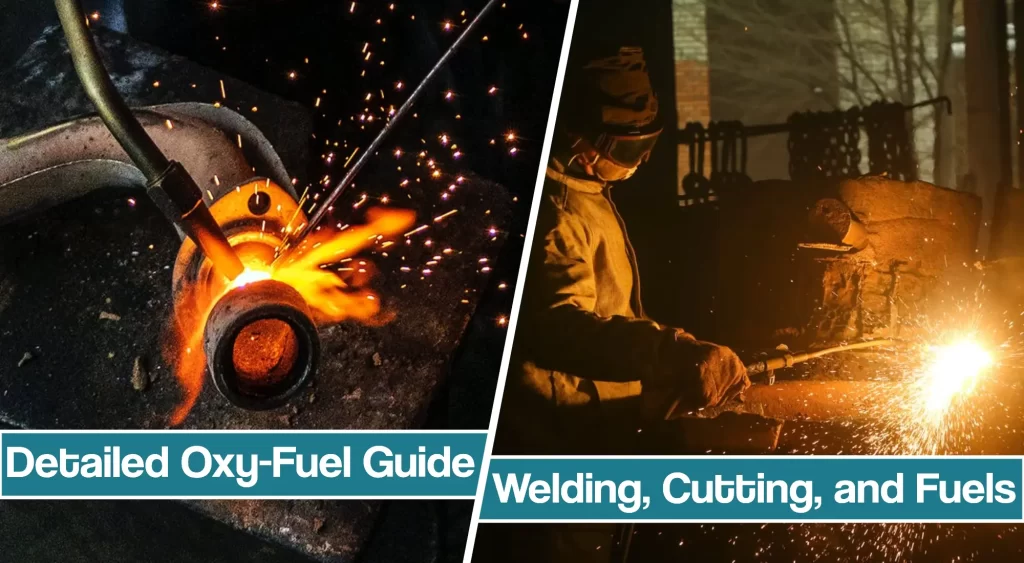
However, gas welding is even used today since it is a flexible and forgivable welding method, making it an excellent choice for amateur and part-time welders. Let’s look at the basics, the good and the bad of oxy-fuel welding.
Oxy-fuel Welding Process Fundamentals
Oxy-fuel welding uses a high-heat, high-temperature flame produced by burning a fuel gas (most commonly acetylene) mixed with pure oxygen. However, keep in mind that three major processes depend on the fuel gas:
- oxyacetylene welding
- oxyhydrogen welding,
- pressure gas welding.
Nonetheless, oxygen can also be mixed with gases such as propylene, butane, and others. The gas used for welding depends on the type of project, cost, and flame control.
This heat is further used to melt interface surfaces of welding plates which are held together to form a joint. You can weld oxy-fuel with or without the help of filler material. If the filler rod is used, it is manually fed directly into the molten weld pool.
Critical Differences Between Oxy-Fuel Welding And Arc Welding
Even though both oxy-fuel welding and arc welding processes such as MIG welding, TIG welding, or Stick use heat to join materials, there is a difference in how heat is formed and the actual temperature.
Arc welding uses electricity as a heat source. As a result, the temperature of the arc reaches roughly 10,000 F.
Meanwhile, Oxy-fuel welding uses a flame as the heat source. The oxygen and acetylene gases reach temperatures up to 6,000 degrees Fahrenheit.
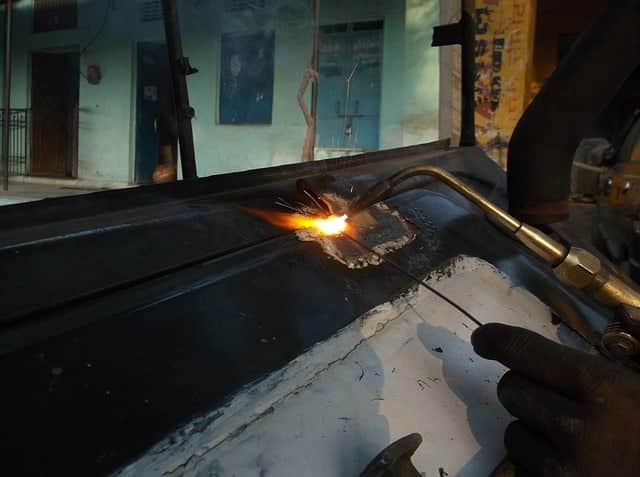
Equipment Used In Oxy-Fuel Welding
Oxy-acetylene welding equipment is portable and easy to use. The essential kit includes the following:
- One of the most critical parts of a gas welding system is the fuel gas. The fuel gas is stored in steel pressurized cylinders that contain oxygen and the fuel gas.
- Gas flow regulators take high pressure from the cylinders and reduce it to working pressure. Typically, this device helps supply oxygen at a steady pressure of between 70 and 130 KN/M2 and the gas supply at between 7 and 103 KN/M2.
- The oxygen and acetylene gases are transferred from the cylinder to the welding torch through the hose. The flexible hoses should be nonporous to reduce the risks of leaks and to help you install them correctly, the oxygen hose is usually green, and the fuel gas hose is typically red.
- Manufacturers made another way to help welders install the hoses correctly. The threaded connectors on the hoses are handed to avoid accidental misconnection. That way, the thread on the oxygen hose is right-handed (as standard), while the fuel gas hose has a left-handed thread.
- Safety valves keep gas flowing in one direction, preventing gas from flowing back into the wrong line or cylinder. For example, a flashback can damage the equipment or even cause a cylinder explosion, so checking the valve’s state is critical.
- Welding torches have a connection and valve for the fuel gas, a connection and valve for the oxygen, a handle for the welder to grasp, and a mixing chamber with a tip where the flame forms. Keep in mind that there is a difference between a welding torch and a cutting torch.
- Since there is no industrial standard system for identifying tip sizes, welders usually compare them to numbered drill sizes.
Oxy-fuel Gases – Propane, Oxygen, Hydrogen And Acetylene
As we mentioned at the start, acetylene gas is the most commonly used fuel in this welding process. However, welders can opt for propylene, liquified petroleum gas (LPG), propane, natural gas, hydrogen, and MAPP gas, depending on the welding operations. In addition, liquid fuel cutting systems use such fuels as Gasoline (Petrol), Diesel, Kerosene, and possibly some aviation fuels.
| Fuel | Temperature |
| Propane and Air | 3590° F |
| Propane and Oxygen | 4087° F |
| Hydrogen and Oxygen | 5087° F |
| Acetylene and Oxygen | 5800 °F to 6300 °F |
Acetylene Gas
Acetylene is the primary fuel for oxy-fuel welding and is the fuel of choice for repair work and general cutting and welding. Acetylene gas is shipped in special cylinders designed to keep the gas dissolved.
There is about 1700 kPa (250 psi) pressure in the acetylene tank when complete. Acetylene, when combined with oxygen, burns at 3200 °C to 3500 °C (5800 °F to 6300 °F), which is the highest among commonly used gaseous fuels.
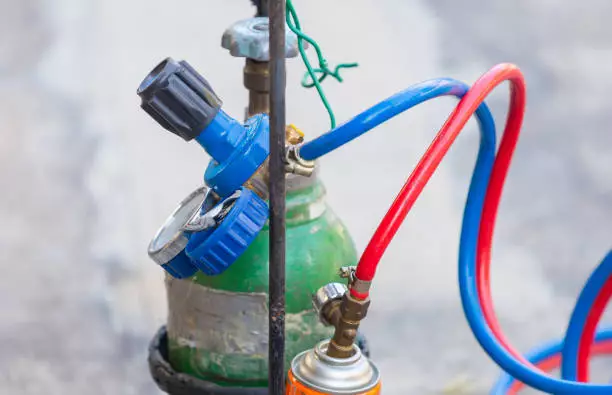
As a fuel, acetylene’s primary disadvantage, in comparison to other fuels, is its high cost, but the overall prices are still lower when compared to arc welding processes.
Hydrogen Fuel Gas
When combined with oxygen, hydrogen produces a clean flame, which is suitable for gas welding aluminum. In addition, since hydrogen can be used at a higher pressure than acetylene, it is ideal for underwater welding and cutting.
When pre-mixed in a 2:1 ratio with pure oxygen, hydrogen can produce a flame temperature of about 2,000 °C (3600 F) at atmospheric pressure. This welding gases mix is often called oxyhydrogen welding.
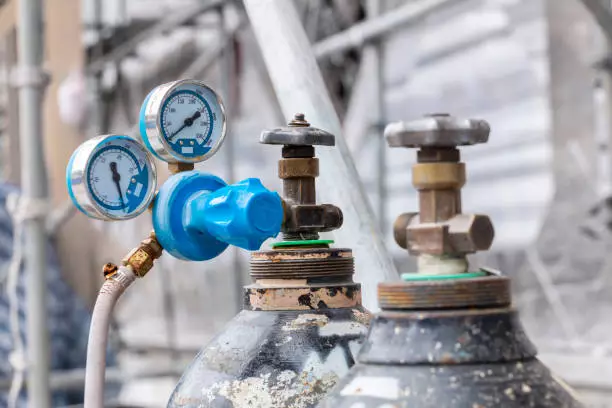
MPS & MAPP Gas
Methylacetylene-propadiene (MAPP) gas and LPG gas are similar fuels because LPG gas is liquefied petroleum gas mixed with MPS. It has the storage and shipping characteristics of LPG and a heat value a little lower than acetylene.
MAPP gas can be used at much higher pressures than acetylene, sometimes up to 40 or 50 psi in high-volume oxy-fuel cutting torches which can cut up to 12-inch-thick low carbon steel.
Propylene Fuel Gas
Propylene is used in production, welding, and cutting. It cuts similarly to propane. When propylene is used, the torch rarely needs tip cleaning. There is often a substantial advantage to cutting with an injector torch rather than an equal-pressure torch when using propylene.
Propane And Butane Gas Fuel
Butane and propane do not react with each other and are regularly mixed. As a result, the calorific (heat) values of the two are almost equal. Both are thus mixed to attain the vapor pressure required by the welders and depending on the ambient conditions.
Propane does not burn as hot as acetylene in its inner cone, and so it is rarely used for welding. Propane, however, has a very high number of BTUs per cubic foot in its outer cone, and so with the injector style torch can make a faster and cleaner cut than acetylene.
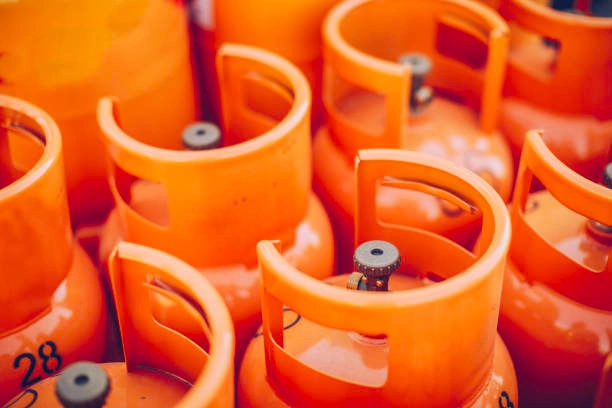
Types of Flames in Oxy-fuel welding
Three types of welding flames can be created with oxy-acetylene (OFW). Each one can be differentiated by its color, size, and shape. In addition, each flame can be made with a unique mixture of acetylene and oxygen.
Therefore, the welder can adjust the oxy-acetylene flame to be carburizing (aka reducing), neutral, or oxidizing.
Carburizing Flame
An excess of acetylene in the oxy-fuel gas mixture creates a carburizing flame. You can distinguish this type of flame by observing three flame zones; the hot inner cone, a white-hot “acetylene feather,” and the blue-colored outer cone.
This type of flame is suitable for low-heat flame applications. Therefore, welders use it for welding nickel, Monel metal, high-carbon steel, and a number of non-ferrous metals. However, you cannot use carburizing flame to weld steel.
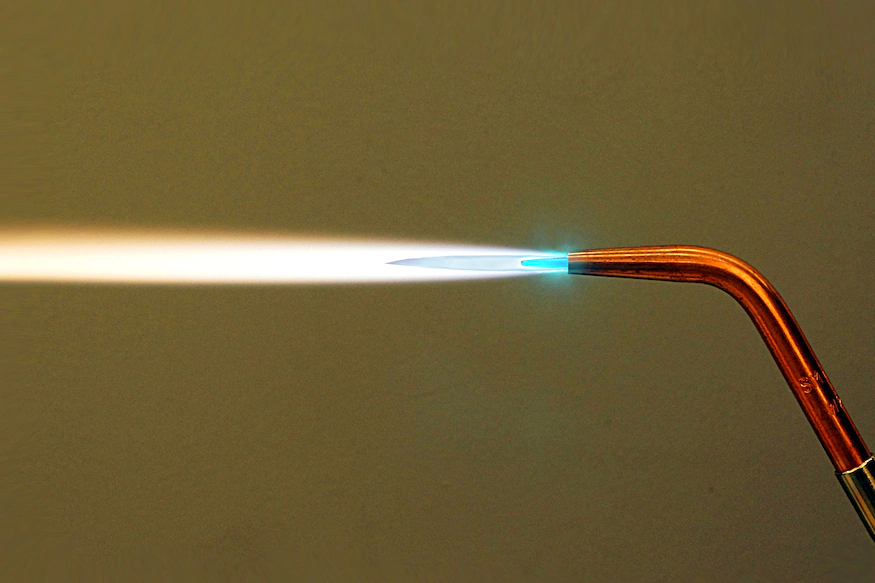
Neutral Flame
The neutral flame is the flame most generally used when welding or cutting. As the name states, you can get a neutral flame by equaling the proportions of oxygen and acetylene gases.
You can distinguish this by observing the light blue inner cone and the darker blue to a colorless outer cone. The light inner cone is the place acetylene and oxygen combine. The tip is the hottest part of the flame, as it provides approximately 6,000 °F (3,300 °C), which is enough to melt steel quickly.
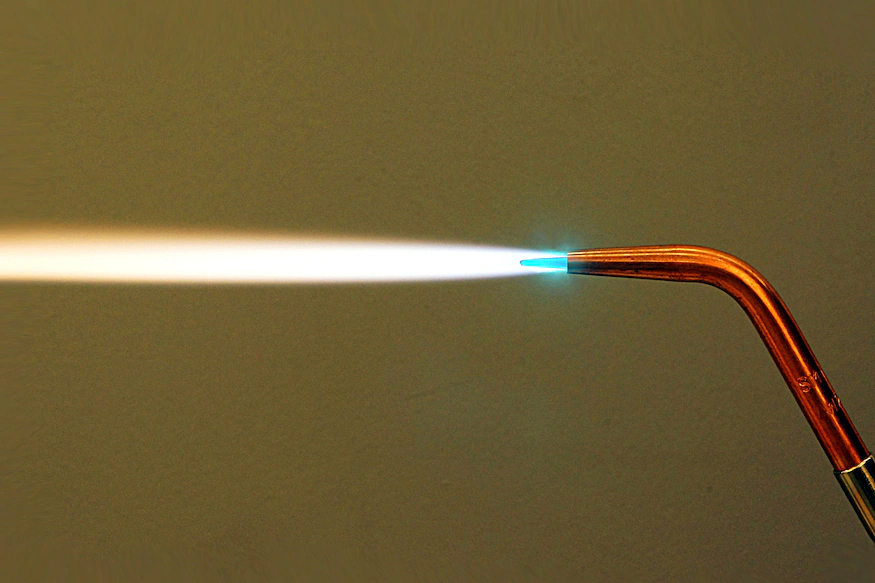
Remember that this is a chemically neutral flame, meaning it creates fewer sparks and does not boil. In addition, neutral flame protects the steel from oxidation, resulting in solid welds.
Oxidizing Flame
An oxidizing flame has a high content of oxygen (the oxygen and acetylene ratio being 1.5:1). Therefore, increasing the oxygen will result in the hissing noise, while the inner cone gets shorter, brighter, and more pointed.
The oxidizing flame creates undesirable oxides, which affect the structural and mechanical properties of most steel plates. That’s the reason why this type of flame isn’t considered to be practical for welding. However, you can still use it when welding copper and alloys of copper, such as bronze and brass.
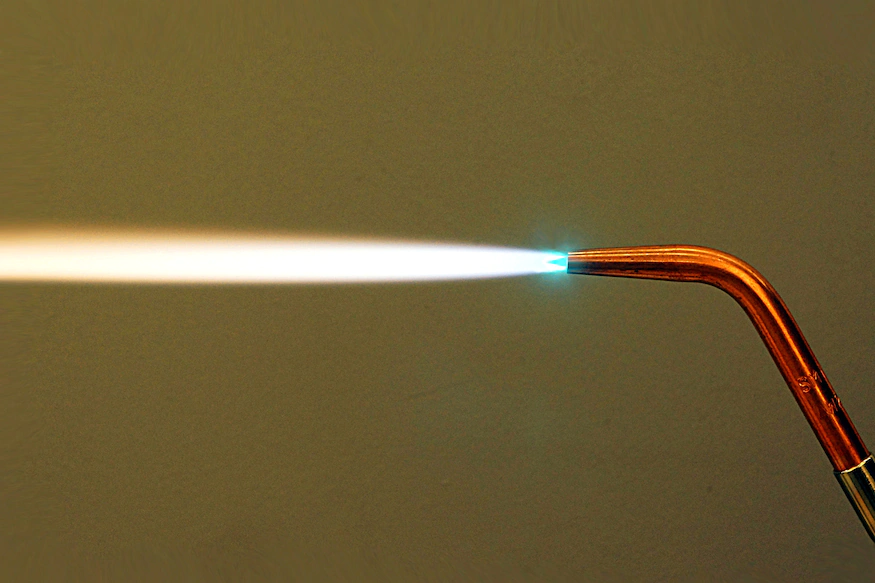
Gas welding Operation Properties
Oxy-fuel welding is used to weld types of metals, including carbon steel, alloy steels, cast iron, aluminum, and magnesium using pure oxygen and fuel/gas. A torch is used to heat two pieces of metals at a temperature that produces a molten pool.
Usually, more metal is added to the puddle by adding a welding rod or filler rod into the molten metal puddle. The metal puddle will travel towards the hottest part of the flame, and that’s why welding torch manipulation is crucial.
The amount of heat depends on the welding tip size, the welding speed, and the welding position.
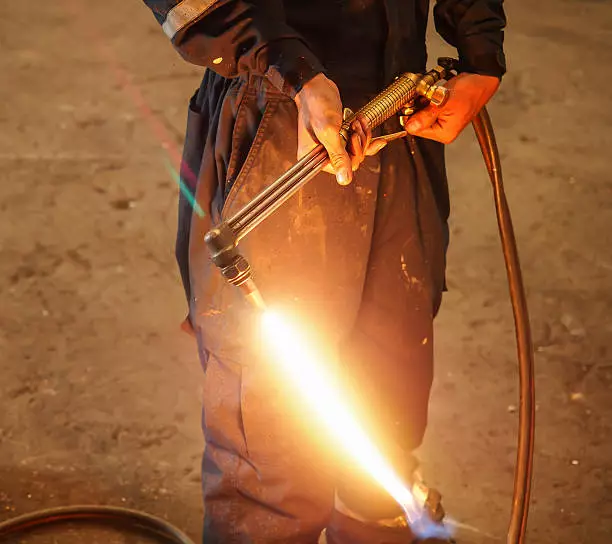
The welding tip size determines the flame size. The metal thickness and the joint design determine the proper tip size.
If your project requires the addition of filler metal, you shouldn’t let the welding flame burn it off. Burning filler material with a hot flame will look like a series of cold dots, affecting the strength of the weld. The weld will be stronger than the original base metal when the filler metal is properly added.
Metal Preparation
Base metal preparation is a crucial part of any welding method, and the oxy-acetylene welding process is no exception. Therefore, you should remove contaminants such as oil, dirt, or oxides, as they can cause incomplete fusion, porosity, or slag inclusions.
The thickness of the base metal at the joint determines the type of edge preparation for gas welding. A butt joint is most commonly used to join materials thinner than 3/16 in., while metals thicker than 3/16 to 1/4 in. require a slight root opening or groove. When joining metals thicker than 1/4 in., edges should be beveled.
Oxy-fuel Cutting
Besides welding, the oxy-fuel process can be used for cutting but with a different approach and setup. A cutting torch has a 60- or 90-degree angled head with orifices placed around a central jet.
The torch blows extra oxygen pressure causing the metal to burn and blowing the resulting molten oxide through to the other side. That’s why the oxygen flow rate is critical. The lesser flow will make a slow, ragged cut, while too much oxygen will waste the fuel and produce a wide concave cut.
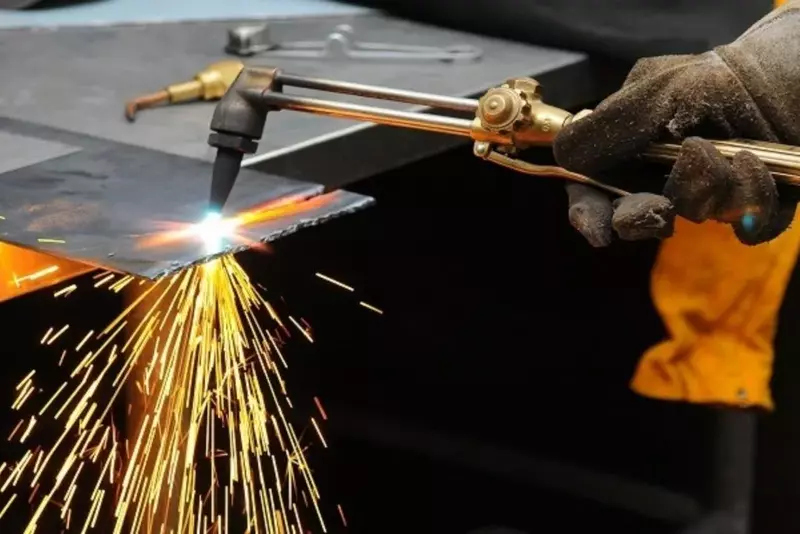
Oxy-propane torches are usually used to cut scraps to save money, while oxy-acetylene can cut only low- to medium-carbon steels and wrought iron.
Oxy-acetylene welding Applications
Oxy-fuel welding, widely known as oxy-acetylene welding is used for smaller home-based shops and metal-based artworks. In addition, it is helpful once when electricity is inaccessible. Moreover, it’s also used for welding pipes as well as tubes.
Meanwhile, oxy-fuel cutting is still vastly used in heavy industry as well as light industrial and repair work, including the automotive industry.
Overall, the this welding and cutting process is mostly used due to its ability to reduce the thickness of metals. In addition, the equipment is also inexpensive and can be used in both ways, manually as well as mechanized.
Resources:
- https://www.twi-global.com/technical-knowledge/job-knowledge/oxy-fuel-welding-003
- https://www.uti.edu/blog/welding/oxy-acetylene-welding
- https://www.twi-global.com/technical-knowledge/faqs/faq-what-is-oxy-fuel-welding
- https://www.motortrend.com/news/oxy-acetylene-welding-101/
- https://www.ioxygen.com/news/view/1354
- https://www.engineeringchoice.com/oxy-acetylene-welding/





